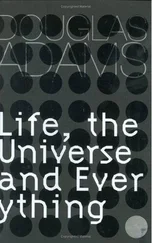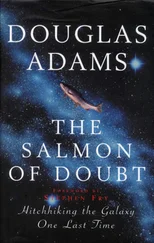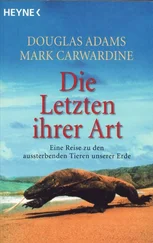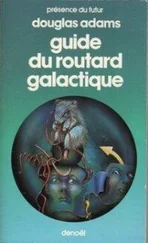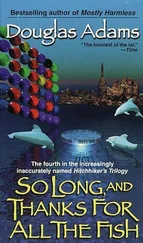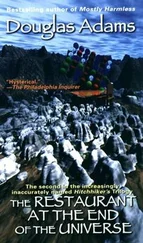Douglas Adams - The Salmon of Doubt
Здесь есть возможность читать онлайн «Douglas Adams - The Salmon of Doubt» весь текст электронной книги совершенно бесплатно (целиком полную версию без сокращений). В некоторых случаях можно слушать аудио, скачать через торрент в формате fb2 и присутствует краткое содержание. Жанр: Фантастика и фэнтези, на английском языке. Описание произведения, (предисловие) а так же отзывы посетителей доступны на портале библиотеки ЛибКат.
- Название:The Salmon of Doubt
- Автор:
- Жанр:
- Год:неизвестен
- ISBN:нет данных
- Рейтинг книги:4 / 5. Голосов: 1
-
Избранное:Добавить в избранное
- Отзывы:
-
Ваша оценка:
- 80
- 1
- 2
- 3
- 4
- 5
The Salmon of Doubt: краткое содержание, описание и аннотация
Предлагаем к чтению аннотацию, описание, краткое содержание или предисловие (зависит от того, что написал сам автор книги «The Salmon of Doubt»). Если вы не нашли необходимую информацию о книге — напишите в комментариях, мы постараемся отыскать её.
The Salmon of Doubt — читать онлайн бесплатно полную книгу (весь текст) целиком
Ниже представлен текст книги, разбитый по страницам. Система сохранения места последней прочитанной страницы, позволяет с удобством читать онлайн бесплатно книгу «The Salmon of Doubt», без необходимости каждый раз заново искать на чём Вы остановились. Поставьте закладку, и сможете в любой момент перейти на страницу, на которой закончили чтение.
Интервал:
Закладка:
But Kilimanjaro is not part of a widespread upheaval like Everest. It was a long time before people managed to work out which bit of the Himalayas was actually the highest, and the discovery was finally made, as I recall, on a desk in London. No such problem with Kilimanjaro. It’s volcanic and stands on its own, surrounded by a few footling little hills. When you finally get to see Killy, searching among the befuddling clouds on the horizon, your blood suddenly runs cold. “Oh,” you say at last, “you mean above the clouds.” Your whole head tilts upward. “Oh my god ...” From base to apex, it is the tallest mountain in the world. It’s certainly a hell of a thing to climb in a rhino costume. This crackpot idea was first put to me months earlier by the founders of Save the Rhino International, David Stirling and Johnny Roberts, and I didn’t realise at first that they meant it. They raved on for a bit about having acquired a whole set of rhino costumes that Ralph Steadman had designed for an opera, and that they would be just the thing for making the ascent of Kilimanjaro in. They had already been used, David told me by way of reassurance, for running in the New York Marathon. “It’ll have enormous impact,” they said, “believe me. Really.” I began to realise the truth of this as we approached our first village of the day, and perhaps now would be a good point to explain what the purpose of the whole expedition was. It was not, in fact, to raise money directly for rhino conservation. Rhinos, which used to be plentiful on the plains of East Africa, are now hideously rare, but in Kenya they are about as well conserved as they can be anywhere in Africa.
Richard Leakey’s Kenya Wildlife Service consists of eight thousand well-trained, well-equipped, well-armed, highly motivated soldiers, and represents a formidable force. Too formidable, some of his opponents feel. Poaching in Kenya is, officially, “no longer a problem.” But conservation is a continually evolving business, and we have begun to realise that just wading into Africa and telling the local people that they mustn’t do to their wildlife what we’ve done to ours, and that we are there to make sure they don’t, is an attitude that, to say the least, needs a little refining. The communities that live along the margins of the great national parks have a tough time. They are poor and undernourished, their lands are restricted by the parks, and when from time to time the odd lion or elephant breaks out of the park, they are the ones who suffer. Arguments about preserving the genetic diversity of the planet can seem a little abstract to someone who has just lost the crops he needs to feed his family or, worse, has just lost one of his family. In the long run conservation can’t be imposed by outsiders, overriding the needs of local people. If anyone is going to take care of the wildlife, then, in the end, it must be the local people—and someone must take care of them.
As we were approaching our first village of the day, the rhino with Todd Jones inside it, was in the lead.
All the walkers took turns at wearing the thing for an hour at a time, and you quickly learned to tell who was in it at any moment from the way in which it moved. If the rhino sauntered, then it was Giles inside.
Giles was an ex-Gordonstoun Hugh Grant lookalike who had spent the last few years hitchhiking languidly around Africa with his own parachute. His technique was to turn up at airfields with this parachute, find someone who was flying in the general direction he wanted to go, hitch a lift, and then, when the fancy took him, just jump out of the plane. Apparently his girlfriend was a top supermodel who, every few months, would find out where he was, fly out there, and then (I’m guessing here) have him washed and sent up to her hotel room.
If the rhino ambled along in a genial way, then it was Tom inside. Tom was a tall, Wodehousian man with exactly the wrong complexion for Africa. He had the amiable air of a member of the landed gentry, and when I asked him where he lived he said, in a vague kind of way, “Shropshire.”
If the rhino bustled along busily, it was Todd inside. Todd was not a mad Englishman because he was Welsh. He was in charge of the rhino costumes, had worn them originally in the opera for which they had been designed, during which he had had to carry enormously heavy sopranos on his back. He told me that he had originally wanted to be a vet, but had ended up being a succession of animals instead. Any time you see a film or TV show or a commercial that features someone dressed up as an animal, it’s probably Todd inside. “I was in The Lion, the Witch and the Wardrobe,” he told me. “Guess,” he added,
“which one I was.” One evening he showed me pictures of his family. Here was a beautiful picture of his wife, another of his young daughter, a sweet picture of his baby son, and here was one of Todd himself.
Todd was done up, very convincingly, as a bright blue centaur.
Gradually the whole point of the rhino suit was beginning to dawn on me. The arrival of the rhino and the Rhino Climb team was something that the village had been looking forward to and preparing for for months. It was the biggest event of the year, a carnival, a festival, a holiday. Being visited by a rhino was something that would be remembered by the villagers, and particularly the children, for years in a way that being visited by a bunch of English toffs in hats would not.
We were then taken to see the village school. Like most of the village, it was made of breezeblocks, and was half-finished. The doors and windows were empty holes, the furniture was just a few rickety benches and some trestle tables, and laid out on these were dozens of pictures of the local wildlife that the children had drawn, and which we were to judge, and give prizes for. The prizes were Rhino Climb baseball hats, and, whoever won the prizes, we had to make sure that every member of the village actually got a hat.
And once we have collected our sponsorship money, we will be able to complete the building of their schoolroom for them.
When at last we left, the children danced along with us for several miles, laughing and singing improvised songs—one of them would start, and the others would quickly pick it up and join in.
The words seem oddly dated, don’t they? It all sounds rather naive and sentimental to be talking about children laughing and dancing and singing together when we all know perfectly well that what children do in real life is snarl and take drugs. But these children/kids/youths, and all the ones we came across on our journey, were happy in a way that we in the West are almost embarrassed by.
The last of the children drop away from us. Our support Land Rover drives slowly past, distributing Cokes and Fantas. Jim, our photographer, is sitting on its tailgate, taking pictures of us with his Canon EOS 1, which I’ve been coveting ever since I saw it. Keis, our Dutch video cameraman, hoists his lightweight Sony three-chip up to his shoulder and pans along the line of walkers. I wonder if there’s anywhere in the West that you could find a hundred children to sing and dance like that.
The following day is my first stint in the rhino suit. I’m much too big for it, and my legs stick out absurdly from the bottom, so that I look like a giant prawn tempura. Inside, the heat and the stench of stale sweat and old Dettol are almost overpowering until you get into the swing of things. Todd walks along beside me, determinedly keeping me engaged in conversation. After a while I realise he’s monitoring me to make sure I don’t faint. Todd’s a good man and I like him a lot. He takes good care of people, and takes even better care of his beloved rhino suit.
Esquire, MARCH 1995
For Children Only You will need to know the difference between Friday and a fried egg. It’s quite a simple difference, but an important one. Friday comes at the end of the week, whereas a fried egg comes out of a hen. Like most things, of course, it isn’t quite that simple. The fried egg isn’t properly a fried egg till it’s been put in a frying pan and fried. This is something you wouldn’t do to a Friday, of course, though you might do it on a Friday. You can also fry eggs on a Thursday, if you like, or on a cooker. It’s all rather complicated, but it makes a kind of sense if you think about it for a while.
Читать дальшеИнтервал:
Закладка:
Похожие книги на «The Salmon of Doubt»
Представляем Вашему вниманию похожие книги на «The Salmon of Doubt» списком для выбора. Мы отобрали схожую по названию и смыслу литературу в надежде предоставить читателям больше вариантов отыскать новые, интересные, ещё непрочитанные произведения.
Обсуждение, отзывы о книге «The Salmon of Doubt» и просто собственные мнения читателей. Оставьте ваши комментарии, напишите, что Вы думаете о произведении, его смысле или главных героях. Укажите что конкретно понравилось, а что нет, и почему Вы так считаете.


